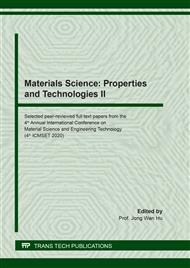p.78
p.83
p.88
p.94
p.99
p.104
p.109
p.114
p.120
Plasticization of Poly(Vinyl Chloride) by Non-Carcinogenic Bio-Plasticizers
Abstract:
In this paper, three different plasticizer molecular sizes namely; glycerol (C3), tributyrin (C15) and trilaurin (C32) was used as non-carcinogenic plasticizers in poly(vinyl chloride) (PVC). The experimental results indicated that all the plasticizers play an important role of PVC toughening. Among of these plasticizers, tributyrin was the most effective for PVC plasticization due to its suitable molecular size. With the presence of tributyrin, PVC was found to tougher and softer which reflected as the increased tensile elongation at break, impact strength and the decreased tensile strength. Morphological study by scanning electron microscope (SEM) exhibited the localized plastic deformations in PVC/plasticized with 15 phr tributyrin. Dynamic mechanical analysis (DMA) showed some shifts of the glass transition temperature (Tg) for all the plasticized PVC compositions. The maximum shift was found when PVC was blended with 15 phr tributyrin. Migration test showed that the plasticizers were easily migrated in ethanol. For the migration in water, it did only slightly.
Info:
Periodical:
Pages:
99-103
Citation:
Online since:
September 2020
Price:
Сopyright:
© 2020 Trans Tech Publications Ltd. All Rights Reserved
Share:
Citation:


